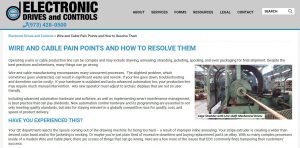[vc_row][vc_column][vc_single_image image=”2937″ img_size=”large”][/vc_column][/vc_row][vc_row 0=””][vc_column 0=””][vc_column_text 0=””]
How EDC Helped Improve Process Control and Operator Safety In Composite Manufacturing[/vc_column_text][/vc_column][/vc_row][vc_row 0=””][vc_column 0=””][vc_separator 0=””][/vc_column][/vc_row][vc_row 0=””][vc_column 0=””][vc_column_text 0=””]
Importance of Torque Control
A client of EDC’s develops composites for some of the most complex and demanding applications in the aerospace industry. One of the company’s core processes involves using winders to wrap continuous composite reinforced film around a rotating mandrel to create strong, lightweight structures. Because these materials are used in critical aerospace components, even small defects—like inconsistencies or contamination—can compromise structural integrity. That’s why precision and quality are essential throughout the winding process.
These winding systems operate at very low speeds, typically just 10 to 20 feet per minute, compared to other industries where speeds can exceed 3,000 feet per minute. Despite the slower pace, the company’s engineers and plant managers were concerned about the risks involved in operator interaction. With hands-on involvement during roll changes and inspections, they wanted greater control over winding torque to reduce the likelihood of injury while also improving process consistency.
A Proof of Concept for Safer, Smarter Winding
As the composite manufacturer’s integration partner, EDC was tasked with developing a reliable low-torque control system. The first step was creating a proof of concept. The client shipped a winder machine frame to EDC’s facility, where engineers designed and validated a custom torque-limiting system. That initial project confirmed that torque could be precisely controlled within strict safety thresholds, laying the groundwork for a full-scale rollout.
The core design logic was based on an empirically determined threshold: 34 pounds of tension. According to the manufacturer’s internal testing, staying under this limit would minimize injury risk during operator contact. From this benchmark, EDC built a control architecture around safety PLCs and redundant torque sensors. Depending on the plant and application, operator presence was managed via scanners, light curtains, or time-based logic that ensured machines entered low-torque mode as needed.
EDC’s approach had to be customized for each site. Three unique low-torque winding systems were ultimately implemented across two different facilities, each tailored to its own equipment configuration, production requirements, and environmental conditions.
Site-by-Site Solutions
Tower Two: Explosion-Proof Environment
This winder operates below the 34-pound threshold at all times, but it’s installed in a Class I, Division 2 explosion-proof zone three feet below floor level due to the use of methyl ethyl ketone (MEK), a low-flashpoint solvent. To meet safety standards, EDC designed a sealed enclosure to house the mechanics and sensors, using a contained explosion-proof motor and hard-plumbed, airtight electrical connections to prevent hazardous vapor infiltration.
Tower Three: Upgrading Manual Control
Previously, operators manually regulated winding tension using pressure clutches and regulators. EDC modernized the system by integrating an AC drive and sensors to automate torque control. A custom stand was fabricated to house a motor and pneumatically actuated tooth clutch, which disconnects the winder from the motor if torque exceeds the threshold.
To add further redundancy, two torque sensors feed data into a safe analog input, read by the safety PLC. If either sensor fails, the system disables operation, ensuring torque remains within specification at all times.
EDC also introduced an automated flagging mechanism: instead of leaning over the winder to place defect stickers manually, operators now press a button and a mechanism applies the sticker automatically, enhancing safety and improving process control.
The Combiner: Multi-Roll System with Operator Interaction
This plant required a dual-motor winding solution for its top-and-bottom roll Combiner. Manual roll changes posed safety and ergonomic risks, so EDC designed a two-motor system and fabricated a custom operator platform that was low enough to avoid the bottom roll, yet tall enough to slide carts underneath for roll swaps.
To manage torque during manual intervention, the system uses a scanner to detect operator presence and enforce low-torque mode for a programmed time window. If the task isn’t completed in time, the winder stops automatically, preventing product contamination from dropped material and ensuring safety during intervention.
Safety light curtains were added in place of originally proposed safety mats (which can be problematic with carts and forklifts). These curtains immediately stop the machine when breached, offering reliable protection without interfering with workflow.
Ongoing Improvement and Industry Relevance
In many facilities, safety upgrades like these only follow incidents or regulatory pressure. In contrast, this manufacturer’s proactive approach was rooted in a top-down commitment to protecting personnel while enhancing process control. As a result, the company has introduced smarter winding operations that not only improve safety but also reduce downtime and improve quality.
While these projects were specific to aerospace composites, the same principles apply across any web-handling application where operators must manually interact with material during winding. That includes paper, film, packaging, and more—anywhere precision torque control and operator safety intersect.[/vc_column_text][/vc_column][/vc_row][vc_row][vc_column][/vc_column][/vc_row]

